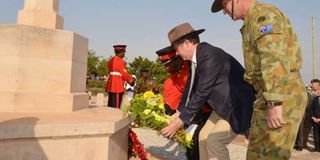Govt elevates 21 historical sites to national monuments

Australian High Commissioner to Kenya Geoff Tooth places a wreath at the Voi Commonwealth War Graves on August 28, 2014. The cemetery is one of the historic sites that has been elevated to a national monument. PHOTO | KEVIN ODIT | NATION MEDIA GROUP
What you need to know:
- The sites are found in Nairobi, Machakos and the coastal region and include some of the most well-known historical places in the country.
- Among them are African Heritage House (Machakos), Kaloleni Social Hall (Nairobi), First Old District Commissioner House Taveta, Methodist Church Hola Mission (Tana River) and Taveta ACK Holy Trinity Church.
- The National Museums and Heritage Act allows the CS to declare a site a monument if he feels the place deserves it.
- Kariokor Cemetery bears a lot of historical importance because fighters who fought for the British in World War II are buried there.
The government has elevated 21 historical sites to national monuments in a bid to guard their importance and raise their profiles among the country’s endeared places.
The sites are found in Nairobi, Machakos and the coastal region and include some of the most well-known historical places in the country.
The Cabinet Secretary for Arts and Culture, Hassa Wario, gazetted the 21 sites through a notice published Friday.
The sites are African Heritage House (Machakos); Kaloleni Social Hall (Nairobi); First Old District Commissioner House Taveta; Methodist Church Hola Mission (Tana River); Taveta ACK Holy Trinity Church, Mahoo; the German Fortress; Voi Commonwealth War Graves; Maktau Indian Commonwealth War Graves; Taveta Indian Commonwealth War Graves; and Taveta Indian Military Cemetery.
Others are Taveta Commonwealth War Graves; Taveta ACK Graves; Maktau Railway Station; Maktau Picket Hill; Salaita Hill (Taita-Taveta); Mau Mau Memorial Site at Hola (Tana River County); Nzambani Rock, Kyuluni; Ukasi Rock (Kitui); Kino Caves (Kenyatta Caves) in Kitui; Nairobi (Kariokor) Cemetery; and Kaloleni Estate Streetscape in Nairobi.
The National Museums and Heritage Act allows the CS to declare a site a monument if he feels the place deserves it.
Members of the public are allowed to challenge the declaration within 60 days.
KARIOKOR CEMETERY
It bears a lot of historical importance because people who fought for the British in World War II are buried there.
The commonwealth War Graves commission said the Nairobi (Kariokor) Cemetery “contains 59 Commonwealth burials of the Second World War, three of which are unidentified.”
KALOLENI SOCIAL HALL
It is a popular historical meeting place in Nairobi.
The first President of Kenya, Mzee Jomo Kenyatta, and Tom Mboya, among other prominent people, at some point convened social and political meetings at the Hall.
SALAITA HILL
This hill is well-known for the "Battle of Salaita Hill’.
It was the first large-scale engagement of the East African campaign of the First World War to involve British, Indian, Rhodesian and South African troops.
Salaita was occupied and made into a strong defensive position by the Germans after August 15, 1914.
The hill was attacked three times by the British, who were pushed back twice on March 29, 1915, when 300 troops were involved, and on February 12, 1916, when 6,000 troops were repulsed.
TAVETA INDIAN COMMONWEALTH WAR GRAVES
According to the Commonwealth War Graves Commission, “the cemetery was used in March and April 1916, after the capture of Latema Nek, but after the Armistice 137 graves were brought in.
"Taveta was occupied by German forces on the August 15, 1914, retaken by the 130th Baluchis in March 1916, and occupied by an Indian Field Ambulance.”
VOI COMMONWEALTH WAR GRAVES
According to the Commonwealth War Graves Commission, “Voi became a hospital centre early in 1916.
"In the period from August 1915 to December 1917, 100 burials were made in the cemetery and after the Armistice, a further 37 graves were brought in from Bura Military Cemetery (14 graves of the 2nd Loyal North Lancs, 29 September 1915), Maktau Military Cemetery (17 graves, largely September 3, 1915) and Tsavo Military Cemetery (six graves).”





